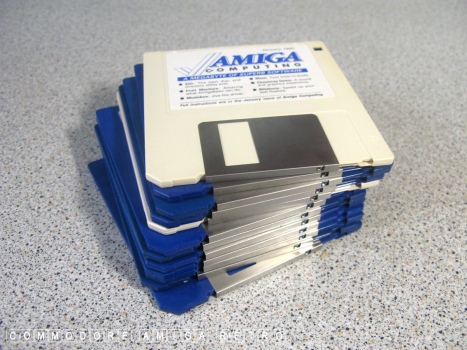Amiga 1.3 - Creating WB disks - Day 3.

Never discard old Amiga disks without first
salvaging at least the drawer and file contents.
Basically a copy of C,libs,devs,tools, etc.

I showed yesterday how the simple 'INSTALL' command
transforms an empty disk to a working bootable disk.
The process gives you the power to create a working
disk that does just what you want to do. Never forget
the power of AmigaDOS.

Like other AmigaDOS commands used in the creation
of the boot disk the file can be found on any number
of Amiga disks. Just load the disk, enter the SHELL
and do a dir df0:c/ and see what comes up. It is never
too late to start collecting your very own AmigaDOS
library of useful tools.

The true magic in creating the boot disk is the file
you create in the 'S' drawer call the 'startup-sequence'
This can be created using your 'ED' tool, yet another
AmigaDOS tool that can be salvaged from cover disks.
This file, as I show later, has the power to add
content to your Workbench window.
Just a tip acquire the AmigaDOS tools Echo and Winsize.

For goodness sake get a manual. So important.

Never forget the power of a disk based operating
system. The Amiga is a disk based system. The power
that this gives to you the user is immeasurable.
In today's internet based world the Amiga gives
you ultimate freedom to do just what you want
without others interfering with what you do.
I say this in the strongest terms, never give
up your floppy drive. It is the key to all that
you can achieve on the Amiga.

ED is a text editor that has no menu or mouse
operation. It works as an extension of the SHELL.
Therefore you need to know the special commands
to enter to edit and save the files you create.

It is odd but to start the editor you can either
target an existing file ie ED df0:s/startup-sequence
or simply type ED 'anything' which creates a new file.

OK back to where I was yesterday, a bootable
disk with apparently nothing on it.

First up lets open the disk with an active
SHELL window so that we can use AmigaDOS
commands and search for files on the disk.

So we fire up ED and access the 'startup-sequence'
and add lines using an AmigaDOS tool 'winsize' and
use the AmigaDOS tool 'echo' to print text on the
screen in the window.
I also set up the RAM icon so it can be seen
on the screen having nabbed a suitable icon
from an Amiga Computing cover disk.

And like magic I have a SHELL window and RAM
icon on the screen.

Time to now rename the main disk using the
drop down menus. Note that these menus are the
exact same menus you get on any Workbench disk.

I'm getting ahead of myself. I will cover icons
in the next blog.

So checking contents just resize the SHELL window
to show more detail and enter dir df0:c/ and see
what magical tools I already posses.

Similar files can be found on any Amiga cover disk
so start nabbing stuff when you open disks. Build your
own library of AmigaDOS and libraries etc.

Personally, where I can, I ADF copy all my
disks so they also become available on the
emulator. Its a great way to review disks by
having them available on the PC.
Anyhoo next up icons. Man do I live icons.


![]()


![]()